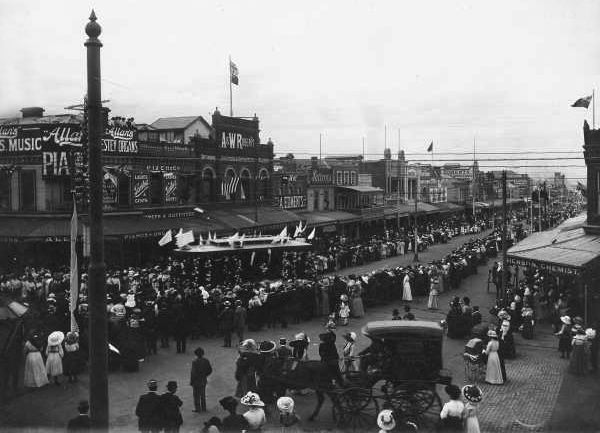 | ||
The city of Geelong in Victoria, Australia, operated an extensive tramway system from 1912 until 1956, when the service was replaced by buses. Unlike Victoria's other major regional cities, Ballarat and Bendigo, which have kept some track and trams as tourist attractions, no trams or tracks remain in Geelong.
Contents
History
There had been proposals to build a tram network in Geelong as early as 1888. Two companies, the Geelong Electric Light, Electric Motor, Electric Tram and Omnibus Company, and the Geelong and District Electric Tramway Company Limited, attended a meeting to get support for their plans in June 1888. After lengthy discussions, and the need to get State Government approval, a plan was finally accepted by the Geelong Town Council in 1890. However the economic depression which occurred after the collapse of the 1880s Land Boom, led to the plans being cancelled in 1891. Further agitation for a tramway started again in 1906, but it took until July 1910 before agreement was reached with the Melbourne Electric Supply Company Limited for the construction and operation of a tram system. The company would have the lease on the trams for a period of 30 years.
Construction began in December 1910, and part of the line was first tested on 10 January 1912 in front of a large crowd. The Geelong tram network was officially opened on 14 March 1912 with bands, huge crowds, and a procession of four highly decorated trams. Official passengers on the trams included the Mayor of Geelong, the Mayor of Newtown and Chilwell, the Mayor of Geelong West, other councillors, directors of the company, and state politicians. At each municipal boundary permission was asked for the trams to enter, and a ribbon was cut.
In 1930 the tramways were taken over by the State Electricity Commission of Victoria (SEC). This was part of the SEC taking over the supply of electricity for Victoria, and it included the tramways in Geelong, Bendigo and Ballarat. A tramway extension to Eastern Beach opened in October 1940 along Bellarine Street to cater to beach goers.
During World War II, passenger traffic increased as a result of petrol rationing and people employed in munitions factories around Geelong. In 1943 the trams carried 6,500,000 people. Because of the shortage of men to work on the trams, the SEC decided to employ women to work as conductors.
Closure
In 1949 Mr. H. H. Bell prepared a report on the Geelong tramways for the Geelong City Council. He found that the trams were obsolete, and could not be run profitably in a city with only 52,000 people. The Council accepted his findings nine votes to one. The Australian Road Safety Council identified trams as being Australia's number one road menace. They were 16 times more likely to be involved in accidents than motor vehicles. Trams were described as being road hogs and a menace. In 1953 a government report recommended replacing the trams with buses. The Liberal state government of Sir Henry Bolte, elected in June 1955, decided in July that the trams should be replaced as soon as possible with privately owned buses. Bolte described the Geelong tramway as being outdated and hopelessly inadequate. The SEC argued that the cost of tickets did not cover the cost of wages, and certainly did not meet the cost of maintenance or electricity. It was estimated that the trams were losing £95,000 each year, and the system needed to have £2,000,000 spent on it to upgrade the tracks and tramcars. Tramway union members argued that the SEC had let the system rundown, and that it lost business by not extending the network into the new suburban areas. The Geelong Chamber of Commerce supported closing the system, with its president saying they would be glad to have the trams off the streets. Protest meetings were held to try and stop the closure, but these were not successful.
The last tram ran from the city to Belmont and back on Sunday, 25 March 1956. Thousands of people were in the streets to celebrate the event. The last tram was Geelong No.4, which had also been the first tram to make the test run on 12 January 1912.
Over the years, there have been proposals to bring trams back into the city. However, none of these proposals have been looked at seriously.
Routes
Immediately following World War II, the following services were through-routed:
After a timetable reorganisation in December 1952, the pattern was altered to:
Trams
The original fleet of Geelong trams was made up of seven single truck cars with bodies made by Duncan and Fraser of Adelaide using Brush trucks. The trams were assembled in the depot in Corio Terrace (now called Brougham Street). There were also four trailers. When the system was closed in 1956 it was running about 30 trams. All the trams were numbered from 1 to 40. Trams were moved around the different tramway networks in Victoria. Geelong No.29 was originally built in 1915 for the Prahran and Malvern Tramways Trust, moved to Geelong in 1928, and then moved to Ballarat in 1936.
There were a variety of different trams operating on the network. Trucks were made by Brush Traction (UK) and J. G. Brill Company (USA). The bodies were made by Brill (USA), Duncan and Fraser (Adelaide), A. Pengelly and Company (Adelaide), and Meadowbank Manufacturing Company (Sydney).
Surviving trams
There are a number of surviving Geelong trams. These are kept in a number of museums including the Tramway Museum Society of Victoria collection at Bylands, the Ballarat Tramway Museum, the Bendigo Tramways, and the Sydney Tramway Museum. Several are also owned privately.
